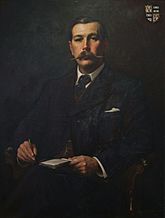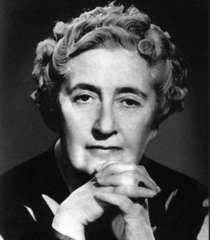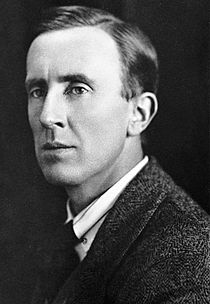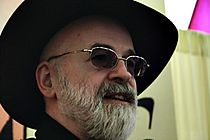Genre fiction facts for kids
Genre fiction, also known as popular fiction, is a way of describing stories that fit into a specific type or "genre." Think of it like different sections in a bookstore, such as mystery, fantasy, or science fiction. Authors write these books to appeal to readers who already love those kinds of stories.
Many famous writers have also written genre fiction. For example, John Banville writes crime novels under the name Benjamin Black. Even Doris Lessing and Margaret Atwood, who are known for serious literature, have written science fiction.
The main types of genre fiction are crime, fantasy, romance, science fiction, and horror. Other popular types include Westerns, inspirational stories, and historical fiction.
Contents
Genre and Book Marketing
In the book world, "category fiction" is another name for genre fiction. These categories are what you see as headings on bookstore shelves, like "Western" or "Mystery."
Some authors famous for "literary fiction" (which doesn't fit into a specific genre) have written genre novels using different names. Others mix genre elements into their literary books.
Genre fiction is very popular. In 2007, romance novels alone made over a billion dollars in the US book market! Science fiction and fantasy also sold hundreds of millions of dollars worth of books.
A Look Back: History of Genres
Genre as a way to classify stories started a long time ago with ancient Greek literature. Poems, prose (regular writing), and plays had special styles that matched the story's theme. For example, there were epic poems and plays like tragedy and comedy. Later, new types like chivalric romance (stories about knights) and opera appeared.
The novel is a long story in prose. Some people think it's a modern invention from the 1700s. However, others say novels have been around for about 2,000 years, since the time of Classical Greece and Rome.
A "romance" is a similar long story. Walter Scott said a romance focuses on "amazing and unusual events," while a novel shows "ordinary human events." But many romances, like Scott's own historical romances and Wuthering Heights, are also called novels. In many other languages, there isn't a separate word for "romance" and "novel"—they are both called le roman or der Roman.
Modern genre fiction grew from different types of novels in the 1800s and became very popular with mass-marketing in the 1900s. This includes the gothic novel (spooky stories), fantasy, science fiction, adventure novel, historical romance, and the detective novel. Some even see early romance novels in books like Pamela, or Virtue Rewarded (1740) and Jane Austen's Pride and Prejudice (1813).
For a long time, some critics thought genre fiction wasn't as artistic as literary fiction. But this idea has changed as more books mix these styles, and universities now study genre fiction seriously.
Popular Genres Today
Here are some of the main genres you'll find in bookstores today:
Fantasy Stories
Fantasy is a type of story that uses magic or other supernatural (beyond natural) things as a main part of the plot, theme, or setting. Many fantasy stories happen in imaginary worlds where magic and magical creatures are common. Fantasy is usually different from science fiction and horror because it avoids scientific or scary themes. However, these three genres often overlap. Fantasy books often take place in a medieval (Middle Ages) setting.
Romance Novels
A romance novel mainly focuses on the romantic love between two people. It must have an "emotionally satisfying and optimistic ending." There are many types of romance novels, including fantasy, historical, science fiction, same-sex romance, and paranormal fiction (stories with ghosts, vampires, etc.).
There's also an older type of "romance" story that Walter Scott described as a "fictional story... where the interest comes from amazing and unusual events." This is different from the modern love story romance novel.
Science Fiction Stories
Science fiction is a type of speculative fiction (stories that imagine "what if?") that deals with ideas like futuristic science and technology, space travel, time travel, parallel universes, and extraterrestrial life (aliens). Science fiction often explores what might happen because of new scientific ideas. It usually avoids supernatural things. Unlike fantasy, science fiction stories traditionally tried to have some connection to real science-based facts or theories, though this isn't always true in modern science fiction.
Horror Stories
Horror fiction aims to scare or disgust its readers. While many horror novels feature supernatural events or monsters, they don't have to. Early horror was inspired by Romanticism and Gothic fiction (dark, mysterious stories). Modern horror tends to be less dramatic and more direct. Horror is often mixed with other genres.
19th-Century British and Irish Genre Fiction
The 1831 story of the Mutiny on the Bounty by Sir John Barrow made the Royal Navy ship HMS Bounty famous. The legend of Dick Turpin, an 18th-century English highwayman, became popular in the novel Rookwood in 1834.
The modern fantasy genre is often said to begin with George MacDonald, who wrote The Princess and the Goblin and Phantastes (1858). William Morris also wrote several fantasy novels in the late 1800s.
The Moonstone (1868) by Wilkie Collins is often seen as the first detective novel in English. The Woman in White is another famous "sensation novel" (a type of thrilling story). H. G. Wells (1866–1946) started his writing career in the 1890s with science fiction novels like The Time Machine (1895) and The War of the Worlds (1898), which describes an alien invasion. Wells, along with Frenchman Jules Verne, is a key figure in developing science fiction.
Penny dreadful publications were cheap, thrilling stories for working-class teens. They introduced characters like the infamous Sweeney Todd. The best ghost story writer of the 1800s was Irish writer Sheridan Le Fanu. His works include Uncle Silas (1865) and Carmilla (1872), a Gothic story about a female vampire. The vampire genre started with John William Polidori's "The Vampyre" (1819). An important later work was Varney the Vampire (1845), which introduced many common vampire ideas like fangs and hypnotic powers. Bram Stoker, another Irish writer, wrote the famous horror novel Dracula, featuring the vampire Count Dracula and the vampire hunter Abraham Van Helsing.

Sir Arthur Conan Doyle's Sherlock Holmes is a brilliant detective in London. He's famous for his intelligence, sharp observation skills, and using clues to solve difficult cases. Holmes's enemy, Professor Moriarty, is often seen as the first "supervillain." Conan Doyle wrote four novels and fifty-six short stories about Holmes from 1880 to 1914. Most of these stories are told by Holmes's friend and helper, Dr John H. Watson.
The Lost World genre was inspired by real archaeological discoveries. H. Rider Haggard wrote an early example, King Solomon's Mines in 1885. Anthony Hope's adventure novels The Prisoner of Zenda (1894) and Rupert of Hentzau (1898) were influenced by European politics.
F. Anstey's funny novel Vice Versa (1882) tells of a father and son who magically switch bodies. Jerome K. Jerome's Three Men in a Boat (1889) is a humorous story about a boating trip. Diary of a Nobody (1892) by George & Weedon is also a classic funny book.
20th-Century Genre Fiction
Early 20th Century
The Riddle of the Sands (1903) by Erskine Childers helped define the spy novel and is called "the first modern thriller."
Emma Orczy's The Scarlet Pimpernel (1903) was first a very successful play in London. The novel was published soon after and became an instant hit. The story is about an English gentleman who secretly rescues people during the French Revolution. Orczy wrote many sequels over the next 35 years. The story has been adapted for TV, film, and a musical. Orczy also created The Old Man in the Corner (1908), an early "armchair detective" (who solves crimes without leaving home), and Lady Molly of Scotland Yard (1910), one of the first female detectives.
John Buchan wrote adventure novels like Prester John (1910) and the four books about Richard Hannay, with The Thirty-Nine Steps (1915) being the most famous. Stories about gentleman adventurers were popular between the World Wars, like H. C. McNeile's Bulldog Drummond (1920) and Leslie Charteris's many books about The Saint.

The early to mid-1900s is called the Golden Age of Detective Fiction. Agatha Christie wrote many crime novels, short stories, and plays. She is best known for her 80 detective novels, especially those featuring Hercule Poirot or Miss Marple. Her influential novels include The Murder of Roger Ackroyd (1926), Murder on the Orient Express (1934), Death on the Nile (1937), and And Then There Were None (1939). Other famous female crime writers include Dorothy L. Sayers (who created Lord Peter Wimsey), Margery Allingham (Albert Campion), and Ngaio Marsh (Roderick Alleyn). Georgette Heyer brought back the historical romance genre starting in 1921 and also wrote detective fiction.

An important early 20th-century science fiction book is A Voyage to Arcturus by Scottish writer David Lindsay, published in 1920. It mixes fantasy, philosophy, and science fiction to explore good and evil. C. S. Lewis and J. R. R. Tolkien were both influenced by it.
From the 1930s to the 1940s, a group of writers at the University of Oxford called the "Inklings" met to discuss literature. Its main members were the important fantasy novelists C. S. Lewis and J. R. R. Tolkien. Lewis is known for The Screwtape Letters (1942), The Chronicles of Narnia (1950–1956), and The Space Trilogy (1938–1945). Tolkien is famous for The Hobbit (1937) and The Lord of the Rings (1954–1955).
Later 20th Century
In thriller writing, Ian Fleming created the character James Bond 007 in 1952. Fleming wrote twelve novels about Bond, including Casino Royale (1953), Live and Let Die (1954), and Dr. No (1958).
In contrast to Bond's big spy adventures, John le Carré wrote spy novels that showed a darker, more realistic world of spying. His novel The Spy Who Came in from the Cold (1963) is considered one of the best in the genre. Frederick Forsyth writes thrillers like The Day of the Jackal (1971) and The Odessa File (1972). Ken Follett writes spy thrillers like Eye of the Needle (1978) and historical novels like The Pillars of the Earth (1989).
War novels include Alistair MacLean's thrillers The Guns of Navarone (1957) and Where Eagles Dare (1968), and Jack Higgins' The Eagle Has Landed (1975). Patrick O'Brian's nautical historical novels, starting with Master and Commander (1969), follow the adventures of the Royal Navy.
In crime fiction, the murder mysteries by Ruth Rendell and P. D. James are very popular.
Nigel Tranter wrote historical novels about famous Scottish warriors like Robert the Bruce and William Wallace.
Science Fiction

John Wyndham wrote post-apocalyptic science fiction, where stories take place after a major disaster. His most famous works are The Day of the Triffids (1951) and The Midwich Cuckoos (1957). Arthur C. Clarke's 2001: A Space Odyssey (1968) is based on his short stories. Other major novels by him include Rendezvous with Rama (1972).
Michael Moorcock (born 1939) writes science fiction and fantasy. He was part of the "New Wave" of science fiction writers who wanted to make the genre more literary. Similarly, J. G. Ballard (born 1930) was known for his "New Wave" science fiction. Later, Iain M. Banks created a fictional, ideal society called "The Culture" in his novels like Excession (1996). Nobel Prize winner Doris Lessing also published a series of five science fiction novels, Canopus in Argos: Archives, between 1979 and 1983.
Fantasy

Terry Pratchett is best known for his Discworld series of funny fantasy novels, which started with The Colour of Magic (1983). Other popular books in the series include Mort (1987) and Hogfather (1996). Pratchett also wrote the 1990 novel Good Omens.
Philip Pullman's fantasy trilogy His Dark Materials includes Northern Lights (1995), The Subtle Knife (1997), and The Amber Spyglass (2000). It follows two children as they explore different parallel universes during big events.
Neil Gaiman writes science fiction, fantasy short stories, and novels. His notable works include Stardust (1998), Coraline (2002), and The Graveyard Book (2009).
Alan Moore's works include Watchmen, V for Vendetta (set in a bad future UK), and The League of Extraordinary Gentlemen.
Douglas Adams wrote the five-book science fiction comedy series The Hitchhiker's Guide to the Galaxy. He also wrote the funny fantasy detective novel Dirk Gently's Holistic Detective Agency.
Horror
Clive Barker's horror novels include The Hellbound Heart.
Age Categories for Fiction
Most types of fiction can also be grouped by the age of the reader they are meant for:
- Children's fiction (for younger kids)
- Middle grade fiction (for ages 8-12)
- Young adult fiction (for ages 12-18)
- New adult fiction (for ages 18-25)
- Adult fiction (for older readers)
See also
 In Spanish: Literatura de género para niños
In Spanish: Literatura de género para niños
- Literary fiction, the type of fiction genre fiction is often compared to
- Stock character (common types of characters in stories)
- Thriller (genre)


